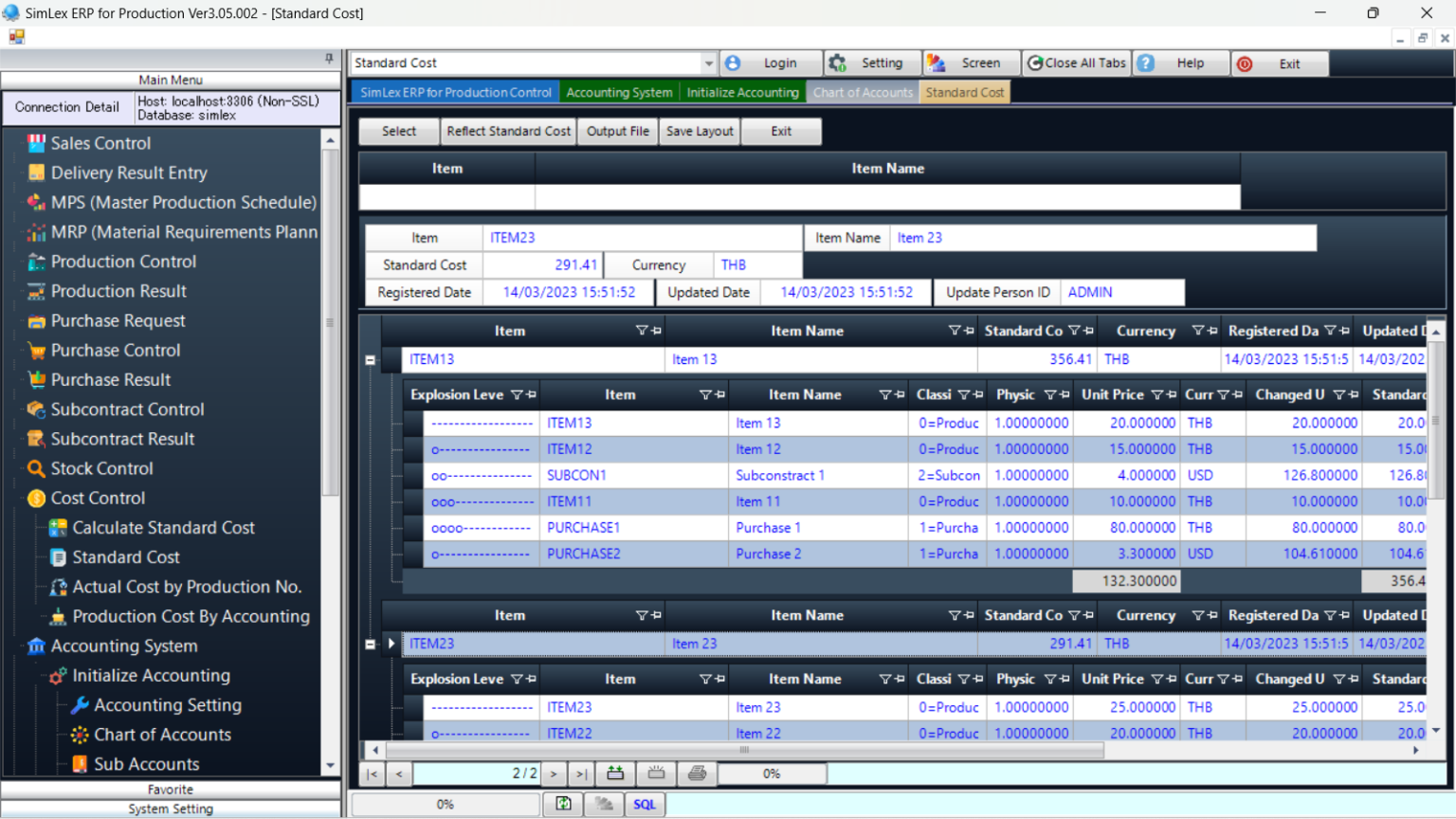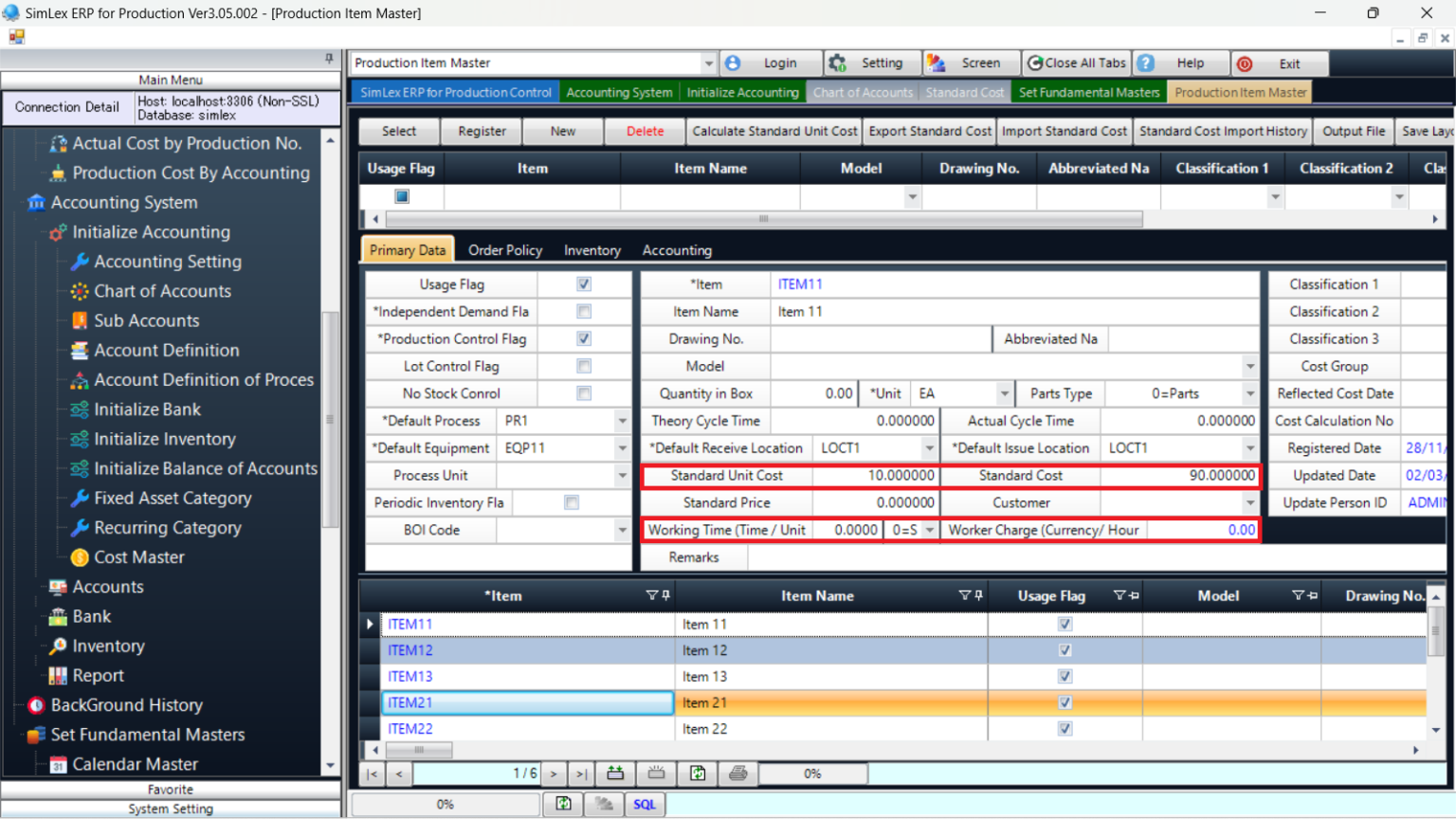
Types of costs in cost control
[standard cost, actual cost, budgeted cost]
- Standard cost : Calculated based on the past 6 months or so
- Actual cost: Calculated based on the previous month's results, and the difference from the standard cost is managed.
- Budgeted cost : Budgeted cost is calculated based on next season's expense schedule and production schedule.
Three costing methods
- Set up standard cost by process in the item master and perform cost calculation.
- Calculate standard cost by process and costing by process charge
- Create departmental journal entries in the accounting system and calculate standard cost, actual cost, and budgeted cost from departmental and common expenses. Direct connection to the accounting system.
In Japan, method (2) is generally used. Regardless of the method (1) or (2), the cost is calculated according to the appropriate allocation conditions from the information in the accounting system indirectly as a result. In other words, no matter which method is used, all cost accounting data is generated from the accounting system.
Required information from accounting system (common expenses need to be allocated under appropriate conditions)
Direct and indirect expenses Depreciation and amortization Consumable supplies Power expenses Rental expenses, etc.
Why do people say they can't see manufacturing costs?
The following are some of the reasons why production costs are said to be invisible.
・When accounting is outsourced in Thailand, the outsourcer does not understand or control cost control itself, which is managerial accounting.
・In Thailand, when accounting is outsourced, there is a lack of cost-computable account setup and departmental accounting when attempting to perform cost control in-house.
・In the case of in-house accounting, the allocation conditions are too complex and complicated to manage for both Thai and Japanese due to the lack of departmentalized accounting.
・If accounting is done in-house, departmental accounting is available, but the system does not allow cost accounting directly linked to the accounting system. Large man-hours.
・In the first place, there are no local personnel who can understand cost accounting.
Costing method based on process charge
②Cost is calculated by process charge
Charge by process = processing cost per minute (assembly) ✕ number of man-hours required to process (assemble) one product
The above process-specific charge is used to calculate the standard cost by process. This method is generally used in Japan. Stacking calculations are made from the bill of materials. The number used is assumed to be 1.
Material cost 100THB
1Standard cost of process 20THB
2Standard cost of process 10THB
3Standard cost of process 50THB
total cost
Material cost 100THB
1Cost of process accumulation 120THB
2Cost of process accumulation 130THB
3Cost of process accumulation 180THB → total cost 180THB / EA
Linkage between accounting system and cost accounting in SimLex ERP
By performing departmental accounting in SimLex ERP, standard cost, actual cost, and budgeted cost can be calculated in conjunction with the fully automated accounting system and costing in SimLex ERP. In addition, all previous calculation histories are saved.
[Departmental accounting] Linked to the process, departmental accounting is performed.
[Standard Cost] Calculate standard cost from expense journal information for the past 6 to 12 months. Allocation conditions include allocation of production man-hours or production quantity, and allocation of common costs to each process.
[Actual costing] After standard costing, actual costing can be performed on a monthly basis (or multiple months) starting from the following month.
[Flow chart of standard costing and actual costing]

*For budgeted costs, the planned production volume, planned expenses, and budgeted exchange rate are required.
Expense Account Master in SimLex ERP

Stack Calculation Results in SimLex ERP (Total Cost)

Standard Cost and Process Charge for Item Master in SimLex ERP

SimLex Development Co., Ltd. Toshio Koga

After graduating from Kyushu University, he worked for a major bearing company and experienced process design in the production technology laboratory. After that, he established SimLex Development Co., Ltd. in Thailand, where he has been developing and selling ERP, production management systems, and accounting systems from zero-based systems up to the present.
